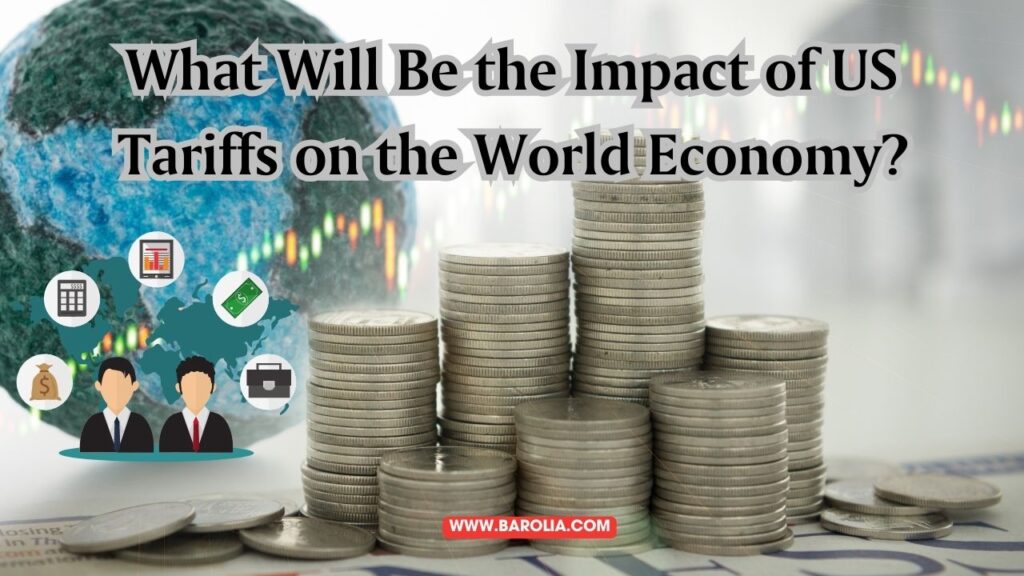In recent years, the United States has used tariffs as a major tool in its trade policies. Tariffs are taxes that a country puts on goods coming from other countries. The purpose of tariffs is often to protect local industries from foreign competition. However, when a big economy like the US imposes tariffs, the effects are felt not just inside the country but around the world.
This article looks at what US tariffs mean for the world economy in simple and easy-to-understand terms.
1. What Are Tariffs and Why Are They Used?
A tariff is a tax that a country places on goods imported from other countries. For example, if the US places a 25% tariff on steel from another country, it means that steel becomes 25% more expensive when it enters the US market.
Governments use tariffs for several reasons:
- To protect local industries from foreign competition
- To raise money for the government
- To punish countries for unfair trade practices
- To push other countries to change their trade behavior
When the US places tariffs on products from other countries, it hopes that Americans will buy more locally made goods instead of imports. But while this may help some local industries in the short term, it can also have many negative effects.
2. Impact on the United States
While tariffs are designed to protect American jobs and industries, they often come with side effects:
a. Higher Prices for Consumers
When tariffs make imported goods more expensive, companies usually pass the cost to the customer. This means people in the US end up paying more for everyday products like clothes, cars, and electronics.
b. Pressure on US Businesses
Many American businesses rely on imported materials. For example, car makers might import steel and electronic parts. If tariffs increase the cost of these materials, it raises the cost of production. This may lead to lower profits or even job cuts.
c. Retaliation by Other Countries
When the US puts tariffs on another country’s products, that country may respond with its own tariffs on American goods. This is known as a trade war. For example, if China or the European Union places tariffs on US agricultural goods, American farmers may lose business.
3. Impact on Other Countries
When the US puts tariffs on imported goods, the exporting countries are affected too. Here’s how:
a. Drop in Exports
Countries that depend on selling goods to the US will lose business. Factories may slow down or shut down, and people may lose jobs.
b. Economic Slowdown
If exports fall, countries may face lower income and less economic growth. This can lead to problems like rising unemployment and less investment in local businesses.
c. Supply Chain Disruptions
Many products are made using parts from different countries. For example, a smartphone might have parts from China, Japan, and the US. Tariffs can break this chain, making it harder and more expensive to produce the final product.
4. Global Trade Uncertainty
One of the biggest impacts of US tariffs is uncertainty. Companies around the world don’t know what will happen next. Will there be more tariffs? Will trade agreements change?
This uncertainty makes businesses nervous about investing. If companies are unsure about the future, they may delay opening new factories, hiring workers, or expanding into new markets. This slows down global economic growth.
5. Impact on Developing Countries
Developing countries often rely on exports to grow their economies. US tariffs can hit these countries the hardest:
- Many developing countries export raw materials or basic goods to the US.
- If demand drops due to tariffs, their income falls.
- This can lead to less money for schools, hospitals, and infrastructure.
For example, countries that export textiles or food products to the US may lose their market share and face serious economic challenges.
6. Changes in Global Supply Chains
When the US raises tariffs on a country like China, companies may look for cheaper places to make goods. This could benefit other countries such as Vietnam, India, or Mexico. Some businesses may shift their manufacturing to these countries to avoid US tariffs.
However, moving supply chains is expensive and takes time. It also creates confusion and new risks. While some countries may benefit in the short term, the global economy as a whole becomes more unstable.
7. Currency and Stock Market Effects
Tariffs can also affect currencies and financial markets. Here’s how:
- When tariffs increase, the value of a country’s currency may drop.
- Investors may pull their money out of risky markets and put it in safer places.
- Stock markets may fall due to fears of a global slowdown.
All these changes can hurt global trade and reduce economic confidence.
8. Long-Term Global Impact
If US tariffs continue for a long time, they may lead to deeper changes in the world economy:
a. Less Trust in Global Trade
Countries may lose faith in the global trading system. They might turn inward, relying more on local markets and less on international cooperation.
b. New Trade Alliances
If countries cannot trade easily with the US, they may form new partnerships. For example, China may strengthen ties with other Asian or African nations. This could create new global trade blocs.
c. Slower Global Growth
Trade helps countries grow by allowing them to sell more and access cheaper goods. If trade becomes harder due to tariffs, global growth could slow down for years.
9. Examples from the Past
The US-China trade war in recent years is a good example. The US placed tariffs on hundreds of billions of dollars’ worth of Chinese goods. China responded with its own tariffs.
The result?
- Prices of some goods went up in both countries.
- Farmers in the US lost business in China.
- Some companies moved production to other countries.
- Global trade growth slowed down in 2019 and 2020.
This shows that while tariffs may have short-term goals, they can create long-term problems.
10. Is There a Better Way?
Instead of using tariffs, many experts suggest other ways to fix trade issues:
- Negotiation: Talk to other countries to solve problems.
- Agreements: Sign fair trade deals that benefit both sides.
- Support Local Industries: Help local businesses grow through innovation, not protection.
Conclusion
US tariffs may be aimed at helping local industries, but they often hurt more than they help. Higher prices, trade wars, and global uncertainty are just a few of the side effects.
In today’s connected world, what happens in one country affects many others. US tariffs don’t just impact American buyers and sellers—they also shake up global markets, affect jobs around the world, and slow down economic growth.
To keep the world economy healthy, countries need to work together, not against each other. Using smart trade policies, fair rules, and open communication is the best way to build a strong and stable global economy.




